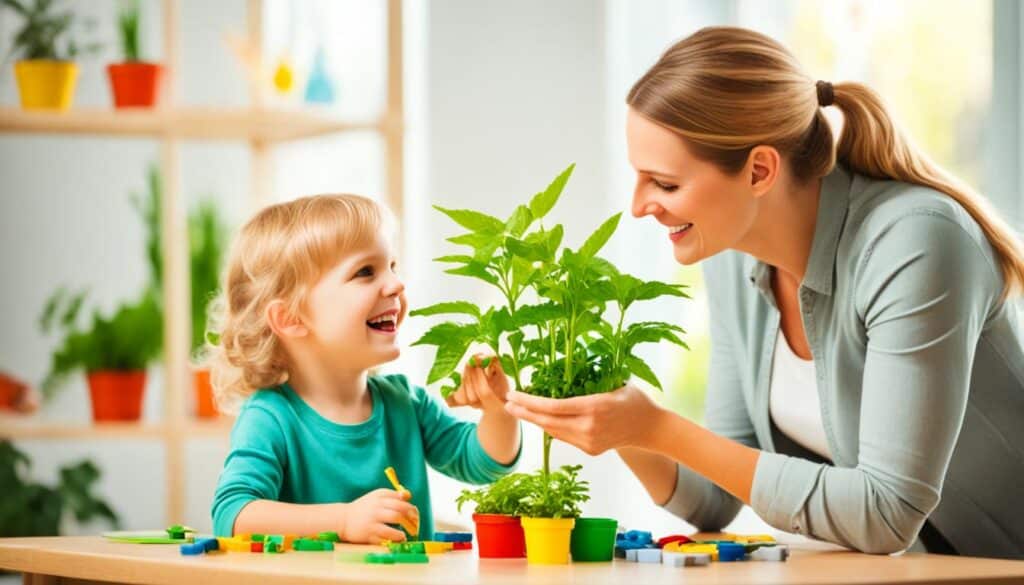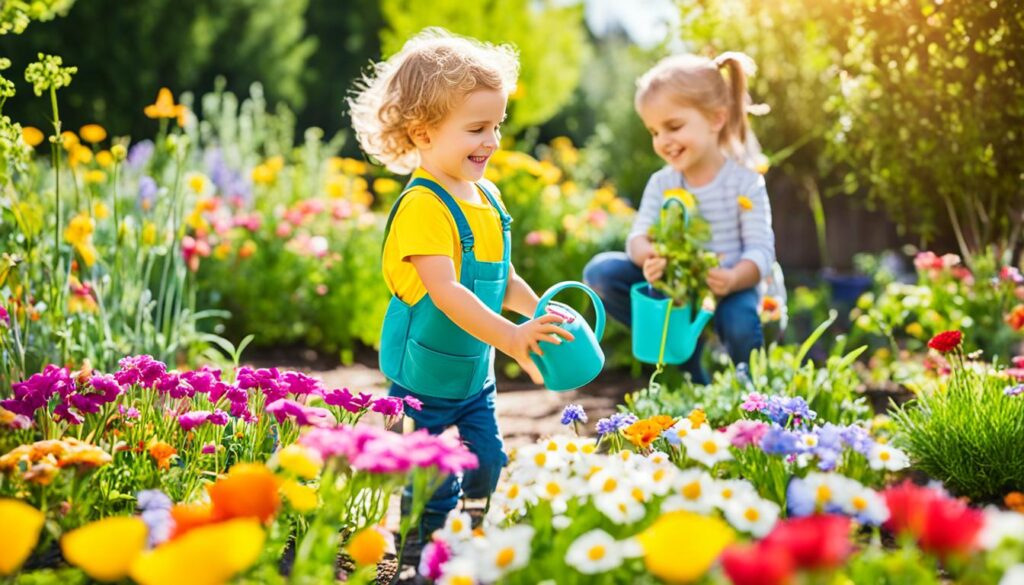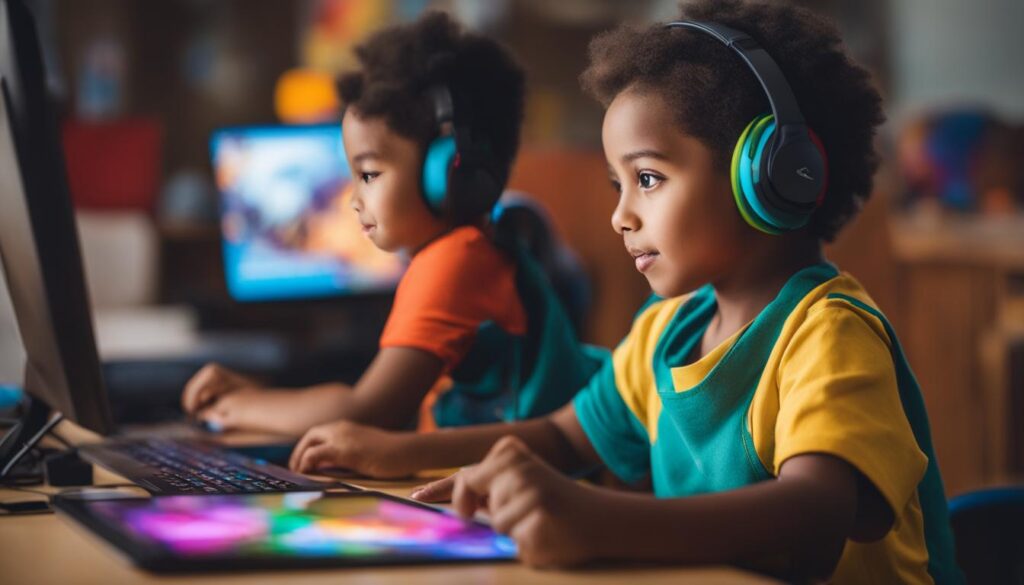Welcome to the resourceful world of effective parenting, where every day is an opportunity to shape a brighter future for our children. Delving into the art and science of child-rearing, we understand that the journey of raising confident children is filled with joy, challenges, and learning curves. Our goal is to empower you with the knowledge and family guidance that resonates with your personal beliefs and the unique needs of your family.
In this guide, we present a curated collection of child-rearing strategies that are not just about enforcing rules but about cultivating a nurturing environment where children can grow to be self-assured and responsible individuals. By bridging traditional wisdom and contemporary insights, we’ll explore how to walk alongside your children, supporting their growth and celebrating each milestone. Let’s embark on this transformative journey together, fostering the skills to raise not just children, but the promising leaders of tomorrow.
Key Takeaways
- Discover the essence of effective parenting that harmonizes love and structure in family life.
- Gain insight into child-rearing strategies for developing self-esteem and resilience in children.
- Learn the art of family guidance, an essential tool in navigating the complexities of modern parenting.
- Uncover secrets to raising confident children, setting them up for success and happiness.
- Identify the challenges and triumphs that come with this lifelong commitment to nurturing the next generation.
Understanding Different Parenting Styles
In the dynamic landscape of child-rearing, parenting styles serve as blueprints that shape child development and family interactions. Developmental psychologist Diana Baumrind’s seminal research in the 1960s identified three key parenting styles: authoritative, authoritarian, and permissive. Later, researchers added a fourth, known as uninvolved parenting. Understanding the nuances of each style is crucial for parents seeking effective strategies that uphold both the wellbeing of their child and family harmony.
Defining Authoritative, Authoritarian, Permissive, and Uninvolved Styles
Authoritative parenting strikes a balance between responsiveness and demandingness, imbuing children with a blend of independence and respect for authority. In contrast, authoritarian parenting is characterized by high levels of demand coupled with low warmth, often resulting in obedient yet less happy children. Permissive parenting offers a high degree of affection but fewer boundaries, leading to issues with self-discipline. Uninvolved parenting, marked by neglectful behavior, typically results in children feeling emotionally detached from their parents.
The Impact of Cultural Background on Parenting
Cultural influences are deeply woven into the fabric of parenting, affecting attitudes, behaviors, and expectations. Diverse cultural backgrounds can predispose parents to favor one style over another, due to societal norms, intergenerational family practices, or community pressures. However, it’s essential to recognize that these cultural practices are part of a broader spectrum of behaviors that shape a child’s upbringing within the context of their unique familial and social environment.
Combining Styles for a Balanced Approach
The pursuit of balanced parenting need not be confined to a single category; instead, it can involve distilling positive elements from each style. An integrated approach allows for flexibility, adjusting techniques in response to a child’s temperament and situational demands. It encourages personalization of parenting methods, catering to every child’s individual needs while promoting growth and responsibility with the stability of a nurturing, structured home environment.
Embracing Positive Discipline in Parenting
The transition from traditional forms of discipline to positive discipline represents a paradigm shift in child behavior management. It is a method that favors mutual respect and effective communication, standing out as a cornerstone for fostering a healthy parent-child relationship. Let’s delve into the strategies that support this constructive approach in detail.

Setting Clear Boundaries and Expectations
Setting boundaries is a fundamental aspect of positive discipline and is essential for creating a safe and predictable environment for your child. Clear rules help define the limit of acceptable behavior, which not only secures a child’s understanding of right and wrong but also instills a sense of security and trust. It is through these boundaries that children learn about consequences and the importance of making responsible choices.
Techniques for Encouraging Good Behavior
To encourage consistently good behavior, behavior encouragement strategies such as praise, reward systems, and modeling appropriate behavior are highly effective. These techniques boost a child’s self-esteem and foster an intrinsic motivation to adhere to the family’s values and norms. Praising specific actions rather than generalizing helps concretize which behaviors are valued, thus promoting repetition of those actions.
How Consistency Shapes Child Development
Consistent parenting is critical in the effective application of positive discipline. Consistency in the enforcement of rules and the administration of consequences provides a stable foundation for children to develop. This reliable structure helps children internalize discipline and understand the predictability of outcomes based on their behavior, significantly influencing their capacity for self-regulation and adaptation in various settings.
Effective Communication Strategies with Children
Effective communication with children is not just about talking to them but to listen and engage in a manner that promotes mutual understanding. It entails employing active listening, displaying emotional intelligence, and maintaining an open dialogue. By focusing on these facets, parents can foster deeper relationships with their children and create a space for positive exchanges and personal growth.
Active listening goes beyond hearing your child’s words. It involves engaging sincerely with what they’re saying, both verbally and non-verbally. Showing empathy, being present, and responding in a way that affirms the child’s feelings are all pivotal techniques in this practice.
Emotional intelligence takes the forefront as parents model how to handle emotions. This capability allows a parent to be aware of the child’s feelings, manage their own emotional responses, and guide children on expressing emotions constructively.
Facilitating an open dialogue with age-appropriate discussions helps in raising children who are comfortable expressing their thoughts and feelings. This open communication pathway enables children to learn and inquire, fostering a sense of security and trust.
Here are practical tips for nurturing excellent communication habits within your family dynamic:
- Encourage your children to share their experiences and feelings, reassuring them that their viewpoints are valid and important.
- Validate emotions before problem-solving when mishaps occur. This strategy allows children to feel understood before moving forward.
- Practice patience and give your child your full attention during conversations, demonstrating that you value their input.
- Use open-ended questions to broaden discussions and invite elaboration.
- Be transparent about your feelings when appropriate, as this teaches children honesty in expression.
When misunderstandings arise, which they inevitably will, having communication strategies already in place can significantly ease resolution:
- Review what was said to ensure understanding.
- Give each party the chance to express their side.
- Find a compromise or solution together, which reinforces teamwork and problem-solving skills.
“The art of communication is the language of leadership.” – James Humes
To further illustrate the benefits of effective communication, consider the following comparative insights in table form, showcasing the contrast between good and poor communication practices in simple daily scenarios:
| Scenario | Poor Communication Example | Effective Communication Strategy |
|---|---|---|
| Child is upset after losing a game | “It’s just a game, don’t be upset.” | “I can see you’re upset about the game. Losing isn’t fun. Let’s talk about what you did well and what we can learn.” |
| Child has not completed homework | “Why haven’t you done your homework? No TV until it’s finished.” | “I’ve noticed your homework isn’t done. Is there something you’re finding challenging that we can talk about?” |
| Child wishes to discuss a sensitive topic | Providing advice immediately without listening completely. | Listening fully before responding and asking questions that guide the child to consider different perspectives. |
In conclusion, by embedding these communication practices into the daily fabric of family life, parents and children together can build a foundation that supports effective dialogue, understanding, and problem-solving. Such an approach paves the way for nurturing future generations equipped with the skills necessary for emotional well-being and interpersonal relationships.
Parenting Methods for Special Needs Children
For parents of children with special needs, embracing individualized parenting methods is fundamental to fostering their child’s growth and development. Tailoring parenting techniques to the child’s unique abilities requires insight, patience, and above all, a deep understanding of each child as an individual. Within this distinctive parenting journey, there are vital pillars of support and collaboration that play a crucial role in nurturing potential and overcoming challenges.
Understanding Your Child’s Unique Needs
Parenting special needs children starts with an in-depth assessment of your child’s specific challenges and strengths. Grounded on this understanding, parents can customize their approach to enhance their child’s abilities while providing the necessary support for areas of difficulty. This form of individualized parenting not only respects but also celebrates the differences, as every achievement, no matter how small, is recognized and encouraged.
Collaborating with Educators and Therapists
Educational collaboration is critical when it comes to integrating a special needs child’s unique requirements with their learning and development. An interdisciplinary team including educators, therapists, and medical professionals can provide a spectrum of perspectives and strategies that contribute to a cohesive plan for the child. This collaborative approach ensures that parenting methods coexist harmoniously with educational programs and therapeutic interventions, promoting consistency across different areas of the child’s life.
Seeking Support: Parent Groups and Resources
A strong support network stands as a beacon for parents navigating the complexities of raising children with special needs. Support groups offer a community of shared experiences and an exchange of knowledge, which can be instrumental in alleviating feelings of isolation. By engaging with such groups, parents tap into a wealth of resources, from emotional solace to practical advice on advocacy and access to specialized services.
Complementary to support groups, a vast array of resources is available to aid in the individualized parenting journey, including books, workshops, and online platforms that offer guidance and inspiration. It is through the combined energies of personal experiences and professional expertise that parents can carve out a path tailored precisely for their child’s narrative.
Here’s a glance at some core topics covered by such groups and resources, with input on the practical steps to take when considering each source of support:
| Support Source | Focus Areas | Actionable Steps |
|---|---|---|
| Parent Support Groups | Emotional support, informative sessions, advocacy guidance | Join a local or online support group; participate in group meetings; share experiences and advice. |
| Therapeutic Resources | Access to therapy, financial assistance, therapeutic toys and tools | Consult with therapists for personalized resources; apply for assistance programs. |
| Educational Workshops | Parenting strategies, behavior management, educational rights | Enroll in workshops; implement learned techniques; advocate for child’s educational needs. |
| Online Platforms | Latest research, parenting tips, community forums | Regularly visit trusted websites and forums; engage with other parents online; stay updated with new findings. |

In embracing the tapestry of individualized parenting, educational collaboration, and support groups, we uncover a resilient network that amplifies the voices and needs of special needs children and their families. Through the synergy of therapy sessions, heart-to-heart conversations with fellow parents, and the wealth of resources available, what emerges is an empowered community steadfast in its commitment to nurturing every child’s potential.
Responding to Behavioral Challenges
When faced with behavioral challenges, parents can often feel tested to their limits. The essence of effective child discipline lies in understanding the root causes of difficult behaviors and responding in ways that guide children toward better choices. Key to this understanding is embracing a range of strategies known to support positive reinforcements and engage children in consistent problem-solving exercises.
Constructive responses to behavioral challenges start with a proactive rather than a reactive approach. Before conflict escalates, there is an opportunity to connect with children to decipher the unarticulated needs or frustrations driving their behavior. Below, you’ll find several methods that can instigate not only immediate compliance but also long-term behavioral growth.
- Employ positive reinforcements consistently to encourage desired behavior instead of dwelling on the negatives.
- Use natural consequences to let children experience the real-world outcomes of their actions, helping them to understand the impact of their choices.
- Foster collaborative problem-solving to equip children with skills to handle future challenges independently.
Moving from punitive reactions to supportive guidance, parents enhance their child’s ability to navigate personal and social hurdles effectively. Here is a quick reference table, illustrating the comparison between common behavioral scenarios and how each can be addressed constructively:
| Behavioral Scenario | Traditional Response | Constructive Approach |
|---|---|---|
| Refusal to follow instructions | Time out without explanation | Discuss the importance of the instructions and offer positive reinforcement for compliance |
| Tantrums in public spaces | Immediate scolding and threats | Remain calm and set an example; address the issue privately and discuss appropriate public behavior afterwards |
| Struggle with sharing toys | Forcing the sharing of toys | Guided interaction to resolve the conflict and recognition when sharing is done willingly |
A particularly effective strategy is to integrate positive reinforcements into everyday routines. Whether it’s through verbal praise, a sticker chart, or granting additional playtime, children are hardwired to respond to positive stimuli. These reinforcements, when consistent, have a significant influence on long-term behavior modification.
Another key element is nurturing problem-solving skills. By involving children in finding solutions to their behavioral challenges, parents empower them with autonomy and responsibility. This collaborative approach fosters a deeper understanding between parent and child and teaches the latter pivotal life skills.
“To change a child’s behavior, change how you view their behavior.” – Anonymous
Through these methods, the aim is to strike a balance between guiding children with firmness and being empathetic towards their developmental needs. Taking a step back and addressing the context of their behaviors allows for more mindful and effective parenting.

In conclusion, when behavioral challenges surface, it’s an opportunity for parents to help their children cultivate better habits through understanding, connection, and positive reinforcement strategies. These experiences not only diffuse immediate tension but also help children develop their own problem-solving capabilities, setting the stage for a life of effective self-regulation and interpersonal skills.
The Role of Quality Time in Child Development
The fabric of family life is enriched when parents and children engage in quality time together, forming the bedrock of healthy emotional and social development. In this fast-paced world, dedicating moments exclusively for family bonding is not just a loving gesture but a critical component in a child’s growth journey.
Creative Activities to Strengthen Bonds
By weaving creative play into the daily routine, families can explore new avenues of connection. From crafting projects to imaginative storytelling sessions, these engaging ventures offer a diverse palette for parents and children to strengthen their bond. Such activities are gateways to shared laughter and the creation of cherished memories.
To inspire families, here’s a list of creative activities that encompass fun and learning:
- Building a fort out of blankets and experiencing an indoor adventure
- Planting a garden together, fostering teamwork and patience
- Hosting a family book club that incites dialogue and critical thinking
- Embarking on a scavenger hunt that hones problem-solving skills

These dynamic interactions not only entertain but also incite a spirit of collaboration and ingenuity, which are vital for a child’s holistic development.
Nurturing Emotional Intelligence through Play
Play is not merely a pastime but a potent tool for cultivating emotional intelligence. As children engage in role-playing games or interact with their peers in a playground setting, they learn to express their emotions, recognize those of others and cultivate empathy. Family activities that incorporate emotional learning through play can have a profound impact on a child’s ability to navigate the complexities of social interactions and personal challenges.
Enlightening moments of play that can nurture emotional growth include:
- Puppet shows that allow children to articulate feelings through characters
- Board games that teach turn-taking and managing disappointment
- Music and movement activities that encourage emotional expression through art
- Sports that emphasize teamwork and coping with various outcomes
Making the Most of Family Time
The essence of making the most of family time encapsulates being fully present, minimizing distractions, and ensuring that every family member feels heard and valued. It involves scheduling regular intervals where family comes first, be it a weekly game night or a daily dinner together. Such dedicated time fosters security and a sense of belonging.
Here are thoughtful ways to enhance these precious occasions:
- Designate tech-free zones or hours, nurturing uninterrupted interaction
- Rotate choosing family activities, ensuring everyone’s interest is accounted for
- Establish traditions, like a cook-off or holiday crafting, adding to a collective family identity
- Celebrate accomplishments, big or small, acknowledging each member’s contribution to the family
Making quality time a priority can often require intention and planning, yet its fruits are invaluable in the grand narrative of a child’s life story.
In the tapestry of parenting, the threads of quality time, emotional intelligence, and creative play intertwine to create a rich mosaic of experiences that underpin a child’s development. It is through these shared moments that the foundation for strong, resilient future adults is laid—a testament to the enduring power of dedicated family activities.
Addressing the Digital Age in Parenting Methods
In this era where technology is a constant presence in our lives, it’s essential for parents to consider the implications of digital consumption on their children. Establishing a framework that incorporates healthy screen time, online safety, and constructive use of educational technology is crucial in modern child-rearing practices.
Setting Healthy Screen Time Limits
One of the primary concerns for parents today is determining screen time limits that foster healthy habits. Balanced screen use is vital, allowing children to benefit from digital devices without adverse effects on their physical or psychological well-being. Guidelines suggest that children aged 2-5 should have no more than one hour of high-quality screen time per day, while older children’s screen time should be monitored to encourage adequate physical activity, sleep, and offline social interactions.
Teaching Online Safety and Digital Citizenship
The internet, while an incredible educational and social tool, presents various risks such as cyberbullying, exposure to inappropriate content, and privacy concerns. Online safety for kids is a top priority, which requires parents to educate their children on the importance of personal information security and the permanence of the digital footprint. Beyond safety, instilling values of digital citizenship ensures that children understand the responsibility that comes with participating in online communities, highlighting the importance of respect, empathy, and critical thinking in digital interactions.
Beneficial Educational Technology for Kids
When used thoughtfully, educational technology can augment learning and development. There are many apps and tools designed with the educational needs of children in mind. Parents can introduce their children to platforms that promote language development, problem-solving skills, and creative expression. Here are some recommendations:
| Category | App/Tool | Educational Benefit |
|---|---|---|
| Reading & Literacy | Epic! | Access to a vast library of books; encourages reading habits. |
| Mathematics | Khan Academy Kids | Interactive activities and lessons to strengthen math skills. |
| Coding | ScratchJr | Introduction to coding principles through creative storytelling. |
| Art & Creativity | Toca Lab: Elements | Exploration of scientific concepts with a playful twist. |
| Language Learning | Duolingo for Kids | Game-like lessons that make language learning fun and effective. |

By integrating these digital resources, children can expand their knowledge and engage with content that aligns with their interests and educational needs. The key is balance and ensuring that screen time is purposeful and complements broader learning goals.
This multifaceted approach to digital parenting supports children in becoming safe, responsible, and skilled navigators of the digital world, setting a foundation for lifelong learning and successful digital integration.
Conclusion
The essence of our parenting journey is marked by an unwavering commitment to growth—both our own and that of our children. We’ve explored a multitude of avenues throughout this guide, navigating through different styles and approaches, each with the potential to contribute to child-rearing success. At its core, adaptive parenting stands out as the compass that guides families through the everchanging landscape of raising children. It is the ability to tailor our methods to the unique personalities and needs of our children that sets the stage for nurturing future generations.
Parenting, inherently, is not a one-size-fits-all venture. It is a dynamic tapestry, interwoven with patience, understanding, and resilience. As we adapt and learn, we pave the way for our children to grow into confident and well-adjusted individuals. The strategies discussed, from fostering effective communication to addressing the intricacies of the digital age, are the tools we carry with us—a toolkit ever-expanding with knowledge and experience.
Ultimately, the articles we share, the conversations we foster, and the bonds we strengthen during this intricate dance with life’s most critical role encapsulate what it means to succeed on this fulfilling yet intricate path. Let the insights gathered here serve as a wellspring of inspiration for all parents seeking to enrich their families’ lives. The shared experiences and lessons offered are a testament to the collective endeavour of nurturing future generations, ensuring the well-being of the children who will shape the world of tomorrow.



